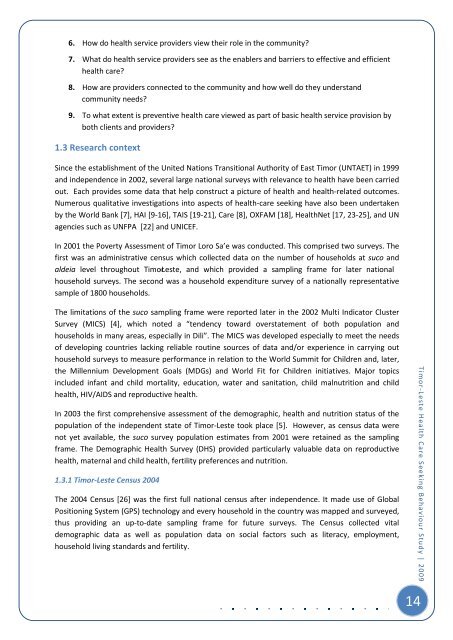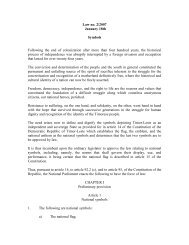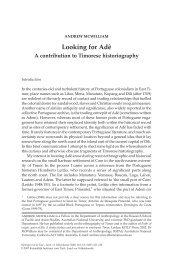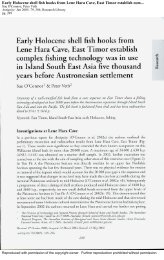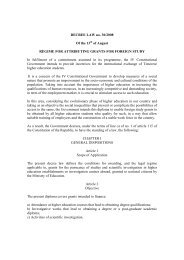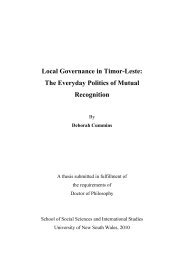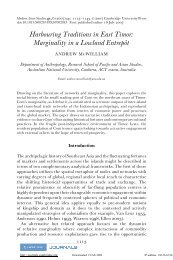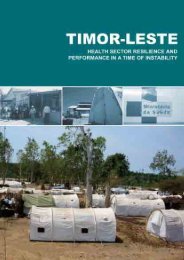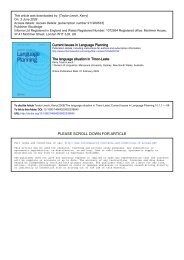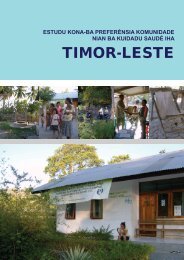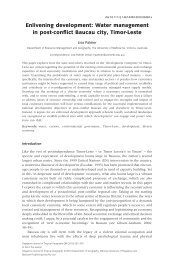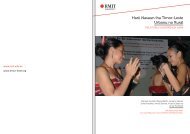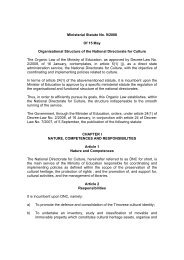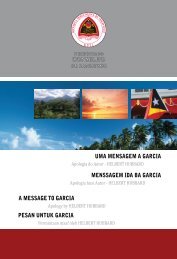Timor-Leste Health Care Seeking Behaviour Study - Secretaria de ...
Timor-Leste Health Care Seeking Behaviour Study - Secretaria de ...
Timor-Leste Health Care Seeking Behaviour Study - Secretaria de ...
- No tags were found...
You also want an ePaper? Increase the reach of your titles
YUMPU automatically turns print PDFs into web optimized ePapers that Google loves.
6. How do health service provi<strong>de</strong>rs view their role in the community?7. What do health service provi<strong>de</strong>rs see as the enablers and barriers to effective and efficienthealth care?8. How are provi<strong>de</strong>rs connected to the community and how well do they un<strong>de</strong>rstandcommunity needs?9. To what extent is preventive health care viewed as part of basic health service provision byboth clients and provi<strong>de</strong>rs?1.3 Research contextSince the establishment of the United Nations Transitional Authority of East <strong>Timor</strong> (UNTAET) in 1999and in<strong>de</strong>pen<strong>de</strong>nce in 2002, several large national surveys with relevance to health have been carriedout. Each provi<strong>de</strong>s some data that help construct a picture of health and health-related outcomes.Numerous qualitative investigations into aspects of health-care seeking have also been un<strong>de</strong>rtakenby the World Bank [7], HAI [9-16], TAIS [19-21], <strong>Care</strong> [8], OXFAM [18], <strong>Health</strong>Net [17, 23-25], and UNagencies such as UNFPA [22] and UNICEF.In 2001 the Poverty Assessment of <strong>Timor</strong> Loro Sa’e was conducted. This comprised two surveys. Thefirst was an administrative census which collected data on the number of households at suco andal<strong>de</strong>ia level throughout <strong>Timor</strong> ‐<strong>Leste</strong>, and which provi<strong>de</strong>d a sampling frame for later nationalhousehold surveys. The second was a household expenditure survey of a nationally representativesample of 1800 households.The limitations of the suco sampling frame were reported later in the 2002 Multi Indicator ClusterSurvey (MICS) [4], which noted a “ten<strong>de</strong>ncy toward overstatement of both population andhouseholds in many areas, especially in Dili”. The MICS was <strong>de</strong>veloped especially to meet the needsof <strong>de</strong>veloping countries lacking reliable routine sources of data and/or experience in carrying outhousehold surveys to measure performance in relation to the World Summit for Children and, later,the Millennium Development Goals (MDGs) and World Fit for Children initiatives. Major topicsinclu<strong>de</strong>d infant and child mortality, education, water and sanitation, child malnutrition and childhealth, HIV/AIDS and reproductive health.In 2003 the first comprehensive assessment of the <strong>de</strong>mographic, health and nutrition status of thepopulation of the in<strong>de</strong>pen<strong>de</strong>nt state of <strong>Timor</strong>-<strong>Leste</strong> took place [5]. However, as census data werenot yet available, the suco survey population estimates from 2001 were retained as the samplingframe. The Demographic <strong>Health</strong> Survey (DHS) provi<strong>de</strong>d particularly valuable data on reproductivehealth, maternal and child health, fertility preferences and nutrition.1.3.1 <strong>Timor</strong>-<strong>Leste</strong> Census 2004The 2004 Census [26] was the first full national census after in<strong>de</strong>pen<strong>de</strong>nce. It ma<strong>de</strong> use of GlobalPositioning System (GPS) technology and every household in the country was mapped and surveyed,thus providing an up-to-date sampling frame for future surveys. The Census collected vital<strong>de</strong>mographic data as well as population data on social factors such as literacy, employment,household living standards and fertility.<strong>Timor</strong>-<strong>Leste</strong> <strong>Health</strong> <strong>Care</strong> <strong>Seeking</strong> <strong>Behaviour</strong> <strong>Study</strong> | 200914


